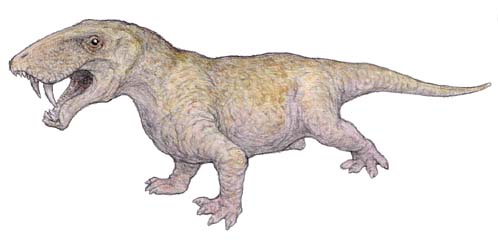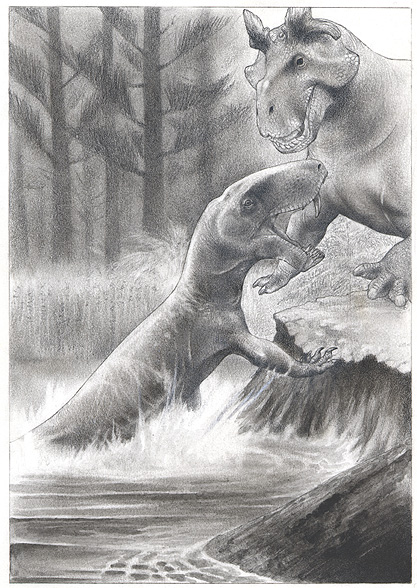
Biarmosuchidae / Eotitanosuchidae
| Palaeos |  |
Therapsida |
| Vertebrates | Biarmosuchia: Biarmosuchidae / Eotitanosuchidae |
| Page Back | Unit Home | Unit Dendrogram | Unit References | Taxon Index | Page Next |
| Unit Back | Vertebrates Home | Vertebrate Dendrograms | Vertebrate References | Glossary | Unit Next |
Abbreviated Dendrogram
SYNAPSIDA | THERAPSIDA `-Raranimus |--Biarmosuchia | |--Biarmosuchidae | `--Ictidorhinidae | `--Burnetiamorpha `-+--Eotitanosuchia `-Eutherapsida |--Dinocephalia | |--Anteosauria | `--Tapinocephalia `--+--Anomodontia | |--Venyukovioidea | `--Dicynodontia `--Theriodontia |--Gorgonopsia `--+--Therocephalia `--CYNODONTIA |
Contents
Index |

 Eotitanosuchus - illustration copyright © Satoshi Kawasaki
|
|||||||||||||||||||||||||||||||||||||||||
| |||||||||||||||||||||||||||||||||||||||||
 Eotitanosuchus attacks Estemmenosuchus; illustration © Seiji Yamamoto |
|
||||||||||||||||||||||||||||||||||||||||
|
Biarmosuchus, known from two skulls and postcrania, was a medium-sized predator, similar in size to a large dog. It was a lightly built, probably agile animal that would have fed on smaller tetrapods. Their legs are quite long, and the animals were probably quite agile in spite of their size.
Eotitanosuchus known from a single large skull without a lower jaw, was without doubt a dominant animal of its environment. Found preserved in flood deposits (once coastal bogs) containing many skeletons of estemmenosuchids, it has been suggested that this large predator was an excellent swimmer, possibly semi-aquatic or frequenting marshy ground. This however is just speculation. The name means "Dawn giant crocodile", which is a bit misleading because although a large preditor it was not huge. A catalogue of a Russian dinosaur exhibition (Vickers-Rich and Rich, 1993) states that the oft-illustratred skull (about 35 cm long) is from a juvenile, an adult has a skull about 1 meter long. I have not found any other information on this, apart from the reference to the eotitanosuchid Ivantosaurus ensifer, known from a jaw fragment from the same locality (Sigogneau-Russell 1989 pp.29-30). So It seems what is being stated here is Ivakhnenko's thesis that this is the adult form of Eotitanosuchus/Biarmosuchus. It is just as likely that this was a distinct animal, and that these were three related forms of different sizes. In any case, assuming that the rest of the creature was in proportion, Ivantosaurus would have been the largest carnivorous therapsid known, exceeding in size even the largest Late Wordian/early Capitanian anteosaurs. References: Sigogneau-Russell 1989, Ivakhnenko, 1999, Vickers-Rich and Rich, 1993 (revised MAK091114, 120127) |
|||||||||||||||||||||||||||||||||||||||||
![Biarmosuchus tener from [S89]](images/Biarmosuchidae1.gif) Biarmosuchidae: Biarmosuchus
Biarmosuchidae: Biarmosuchus
Range: Middle Permian of Russia
Phylogeny: Biarmosuchia: Ictidorhinidae + *.
Characters: Long dorsal process of premaxilla [S89]; very narrow interorbital roof (?!) [S89]; short lateral postorbital bone, not reaching the level of the ventral border of the orbit [S89]; paroccipital process reaches quadrate [S89]; parasphenoid keeled ventrally [S89]; long palatal dentigerous tuberosities [S89]; mandibular symphysis not sloping [S89]; incisors perhaps without a heel(?) [S89]; short cervical vertebrae, but longer than dorsals, and with a ventral keel [S89]; long neural apophyses [S89]; slightly divergent zygapophyses [S89]; interclavicle very wide anteriorly [S89]; humerus with feeble torsion and with entepicondylar foramen [S89]; humerus wide distally [S89]; ilia widen only slightly anteriorly (means ilia diverge slightly? bones transversely broader? or what?) [S89]; pubis very strongly developed [S89]; slender limbs [S89]; phalangeal formula 23454 [S89].
Links: Gondwana Studios; Lecture 03 - Cont. Drift (but where is he getting this information?); synapsurv.PDF; THE FOSSIL RECORD; therapsid3a.
References: Sigogneau-Russell (1989) [S89]. ATW030224.
Eotitanosuchia: Eotitanosuchus, Ivantosaurus, Kamagorgon.
Range: Middle Permian ( (Late Roadian/early Wordian).) of Russia.
Phylogeny: Therapsida::::: Eutherapsida + *.
Characters: Large (2.5 meters (possibly upto 6m?), carnivorous forms; incisors & postcanines small; canines very large; no precanines; vomers incompletely fused; pterygoid narrow posterior to transverse flanges, with quadrate rami almost parallel; interpterygoid vacuities small; dorsal process of premaxilla elongated; maxilla reaches maximum height in posterior; some pachyostosis of upper orbital rim; postorbital bar slightly twisted; $ temporal fenestra larger than biarmosuchids, with expanded (& thickened?) posterodorsal margin for origin of jaw adductors visible in dorsal view (H&B); lack moveable quadrate; paroccipital process contacts quadrate.
 Until recently only two genera -- each of one species, are recorded -- Eotitanosuchus
and Ivantosaurus. The latter is known from only two jaw fragments, and seem to be very
similar to Eotitanosuchus. Tatarinov (1999) has
recently described
a new species and genus of eotitanosuchian.
Until recently only two genera -- each of one species, are recorded -- Eotitanosuchus
and Ivantosaurus. The latter is known from only two jaw fragments, and seem to be very
similar to Eotitanosuchus. Tatarinov (1999) has
recently described
a new species and genus of eotitanosuchian.
Genus Eotitanosuchus Chudinov 1960
Type species: E. olsoni Chudinov 1960
Diagnosis: Snout long and high; orbit large; interorbital roof narrow;
occiput high; step in the alveolar border (?); lacrimal high and long; vomers
fusing (= partially fused?).
Eotitanosuchus olsoni Chudinov 1960
Locality: Echovo locality, Ocher Province, Perm Region, eastern European
Russia
Age: Upper Kazanian, Middle Permian (Late Roadian/early Wordian)..
Size: skull: 35 cm, overall length may have been over 2 meters
The holotype is a crushed and deformed skull. Additional skull and skeletal material is known. There are 8 or 9 small and flattened postcanines in the jaw. Eotitanosuchus is found preserved in flood deposits (once coastal bogs) containing many skeletons of estemmenosuchids.
Ivantosaurus ensifer Chudinov 1983 ? = Eotitanosuchus
ensifer (Chudinov)
Locality: Echovo locality, Ocher Province, Perm Region, eastern European
Russia
Age Upper Kazanian, (Late Roadian/early Wordian).
Holotype and only known material, maxilla and quadrate found in
association and in their respective natural positions.
Either a giant individual of Eotitanosuchus (if E. olsoni is a juvenile this would therefore be a large adult), or, perhaps more likely, a distinct species. This is a very large animal (length would have been around 6 meters). Maxilla short and high. Two upper canines, long, and with their axes inclined forward. It is not clear if one of the canines is a replacement tooth. Sigogneau-Russell (1989) seems to think this is unlikely, which would make this a quite different animal from Eotitanosuchus. As with the therocephalian "family" Lycosuchidae, these may simply be replacement canines. There are few known animals, living or extinct, with two sets of canines (it would be a very inefficient chewing mechanism)
Kamagorgon ulanovi Tatarinov 1999
Locality: Sokol locality, Udmurtia,
Western part of the Middle Urals, Perm region, Russia
Age Upper Kazanian (Late Roadian/early Wordian)..
material: Based on an incomplete skull
The snout is relatively short, the canines are massive and long, the parietals are thickened, and the mandibular symphysis is extremely high. The palatal teeth cover the pterygoids and palatines and are not concentrated on special bony tubercles.
Links: Eotitanosuchus; Stars of the Show (A to I); therapsid3a; Paleontology and Geology Glossary: E.
References: Battail & Surkov (2000); Hopson & Barghusen (1986); Ivakhnenko (1999); Sigogneau-Russell (1989); Tatarinov (1999).
Image: Three specimens of Biarmosuchus tener (a-c) compared to Eotitanosuchus olsoni (d) as reconstructed by Ivakhnenko (1999). ATW020727; MAK000808.
| Page Back | Unit Home | Page Top | Page Next |
checked ATW031025; last modified MAK120127